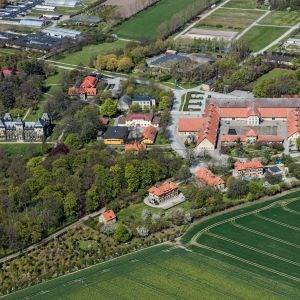The campus development process

Campus Alnarp is a unique place with a rich history. The ongoing development process includes both renovations and new construction to meet the needs of its operations in the short and long term. In December 2027, we will have a train stop in Alnarp, and the two faculties at Campus Alnarp will utilise new land for research facilities. We see the potential for Alnarp to contribute to and serve as a model for more sustainable societal development in southern Sweden, as well as nationally and globally. The level of ambition should be high.
Background
Plans and investigations
In 2012, the Campus Plan Vision Alnarp was created through collaboration between SLU and Akademiska Hus. Roughly five years later, the parties decided to jointly revise the document and collectively investigate how the physical environment at Campus Alnarp can be developed to best support SLU's operations in the future. In 2019, the vice-chancellor decided on a new Campus Plan Alnarp (only in Swedish).
Well-functioning facilities are as important as an inspiring outdoor environment for research and education. Several investigations from various perspectives have been conducted by reputable landscape architects.
In addition to this, decisions have been made regarding train connections to Alnarp.
Guiding principles
There are seven guiding principles for the design of spaces and the physical environment in Alnarp. These principles serve as a platform and guide for both overarching and detailed decisions.
The principles were developed, among other things, through a workshop series in the spring of 2021. The principles are:
- A coherent campus
- Enable progress and collaboration
- Simplify our workday
- Integrating the outdoors and indoors
- Stands out
- Sustainability
- Student life
Vision and objectives
In the work of revising the campus plan for Alnarp, a new vision and new overall goals have been developed and have now been decided:
Vision:
Campus Alnarp – a green hub of knowledge at the heart of a dynamic, learning landscape, leading the way towards a sustainable society.
Objectives:
- Guarantee the long-term needs of the core operations.
- Develop the landscape, park environment and buildings into a collaboration for an outstanding environment for research, education and innovation.
- Develop the campus into an inspirational and pedagogical meeting point that sets an example for society.
- Complement the campus with functions and activities that align with the vision and contribute to a secure and attractive space.
Collaboration with Lomma municipality and Akademiska hus
The development work is conducted by SLU in collaboration with Lomma Municipality and Akademiska Hus. Through this collaboration, we aim to increase the opportunity to develop Alnarp into a unique place for innovation, collaboration, and a high-quality living environment for all present and future users and stakeholders.
This collaboration occurs both through specific projects and at an overarching level through biannual check-ins.
Some collaborative projects include the train stop and the irrigation issue.
Governance and Organisation
Here you can read about how the work on campus development is organised and managed.